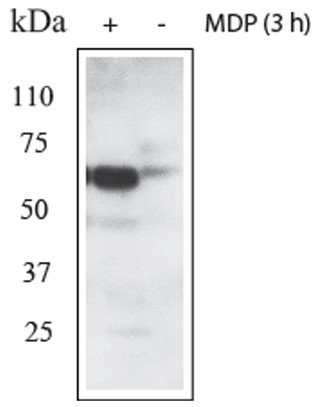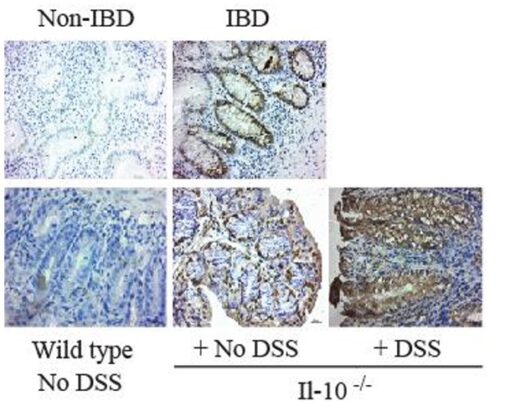Anti-Human pThr474 RIPK2 Rabbit Polyclonal Antibody (19510)
Data
 Immunoblotting: use at a dilution of 1:500. Detection of RIPK2 in MDP-stimulated HEK293 cells (+) vs. non-stimulated HEK293 cells (-).
Immunoblotting: use at a dilution of 1:500. Detection of RIPK2 in MDP-stimulated HEK293 cells (+) vs. non-stimulated HEK293 cells (-). Immunohistochemistry: use at a dilution of 1:100. Detection of active RIPK2 in human (top) and mouse (bottom) tissues. Non-IBD refers to colon sections from non-inflammatory bowel disease (IBD) patients; IBD refers to colon sections from ulcerative colitis (UC) patients. Mouse strain used: B6.129P2-I110tm1Cgn/J, a common model for IBD that presents with spontaneous colitis that is elevated by DSS (dextran sulfate sodium) exposure.
Immunohistochemistry: use at a dilution of 1:100. Detection of active RIPK2 in human (top) and mouse (bottom) tissues. Non-IBD refers to colon sections from non-inflammatory bowel disease (IBD) patients; IBD refers to colon sections from ulcerative colitis (UC) patients. Mouse strain used: B6.129P2-I110tm1Cgn/J, a common model for IBD that presents with spontaneous colitis that is elevated by DSS (dextran sulfate sodium) exposure. - -
- -
Antibody DetailsProduct DetailsReactivity Species Human ⋅ Mouse Host Species Rabbit Immunogen Phosphopeptide corresponding to the pY474 site of human RIPK2. Product Concentration Lot Specific Formulation Whole antiserum State of Matter Liquid Storage and Handling Store at -20°C in appropriate aliquots to avoid multiple freeze-thaw cycles. Country of Origin USA Shipping Next Day 2-8°C Applications and Recommended Usage? Quality Tested by Leinco Immunoblotting: use at a dilution of 1:500. Detection of RIPK2 in MDP-stimulated HEK293 cells (+) vs. non-stimulated HEK293 cells (-).
Immunohistochemistry: use at a dilution of 1:100. Detection of active RIPK2 in human (top) and mouse (bottom) tissues. Non-IBD refers to colon sections from non-inflammatory bowel disease (IBD) patients; IBD refers to colon sections from ulcerative colitis (UC) patients. Mouse strain used: B6.129P2-I110tm1Cgn/J, a common model for IBD that presents with spontaneous colitis that is elevated by DSS (dextran sulfate sodium) exposure. These are recommended dilutions. End users should determine optimal dilutions for their applications. Each investigator should determine their own optimal working dilution for specific applications. See directions on lot specific datasheets, as information may periodically change. DescriptionSpecificity This polyclonal antibody is specific for phosphorylated (pThr474) of human and mouse RIPK2. Background RIPK2 (Receptor Interacting Protein Kinase 2) is the obligate kinase of the NOD2 intracellular pathogen recognition pathway receptor and an upstream kinase activator for NFκB via activation of TAK1. NOD2 is activated by muramyl dipeptide (MDP), a natural component of Gram-positive and Gram-negative bacteria. Upon NOD2 activation, RIPK2 is recruited to NOD and becomes activated via a tyrosine and serine phosphorylation and protein-dependent poly-ubiquitination. Active RIPK2 activates TAK1 and subsequently IKK (IκB kinases) followed by the movement of the NFκB dimer (p50 and p65) to the nucleus to turn on gene transcription. Thus, RIPK2 can play a role during inflammation injury in a number of disease settings. Antigen DetailsFunction Serine/threonine/tyrosine kinase that plays an essential role in modulation of innate and adaptive immune responses. Upon stimulation by bacterial peptidoglycans, NOD1 and NOD2 are activated, oligomerize and recruit RIPK2 through CARD-CARD domains. Contributes to the tyrosine phosphorylation of the guanine exchange factor ARHGEF2 through Src tyrosine kinase leading to NF-kappaB activation by NOD2. Once recruited, RIPK2 autophosphorylates and undergoes 'Lys-63'-linked polyubiquitination by E3 ubiquitin ligases XIAP, BIRC2 and BIRC3. The polyubiquitinated protein mediates the recruitment of MAP3K7/TAK1 to IKBKG/NEMO and induces 'Lys-63'-linked polyubiquitination of IKBKG/NEMO and subsequent activation of IKBKB/IKKB. In turn, NF-kappa-B is released from NF-kappa-B inhibitors and translocates into the nucleus where it activates the transcription of hundreds of genes involved in immune response, growth control, or protection against apoptosis. Plays also a role during engagement of the T-cell receptor (TCR) in promoting BCL10 phosphorylation and subsequent NF-kappa-B activation. Plays a role in the inactivation of RHOA in response to NGFR signaling (PubMed:26646181). {PubMed:14638696, PubMed:17054981, PubMed:18079694, PubMed:21123652, PubMed:21887730, PubMed:26646181}. NCBI Gene Bank ID UniProt.org Research Area Cancer . Inflammatory Disease . Innate Immunity . Neuroscience . Alzheimer's Disease . Neurodegeneration . Parkinson's Disease . Stroke References & Citations1. Salla M, et al. 2018. J Pharmacol Exp Ther. 365: 354-367. 2. Zare A, et al. 2018. Cancers. 10: 184. 3. Larochelle J, et al. Exp Neurol. 2024 Jul;377:114812. Epub 2024 May 9. PMID: 38729551. 4. Larochelle J, et al. J Neuroinflammation. 2023 Sep 30;20(1):221. PMID: 37777791. 5. Salla, M., et al. Int. J. Mol. Sci. 2023, 24, 5967. https://doi.org/10.3390/ijms24065967. 6. Bo Am Seo, et al. bioRxiv 2024.02.19.580982; doi: https://doi.org/10.1101/2024.02.19.580982. 7. Xu Y, Lin F, Liao G, Sun J, Chen W, Zhang L. Mol Neurobiol. 2024 Sep;61(9):6771-6787. doi: 10.1007/s12035-024-03981-4. Epub 2024 Feb 13. PMID: 38349514. 8. You J, Wang Y, Chen H, Jin F. Front Pharmacol. 2023 May 30;14:1192970. doi: 10.3389/fphar.2023.1192970. PMID: 37324457; PMCID: PMC10266216. Technical Protocols |


